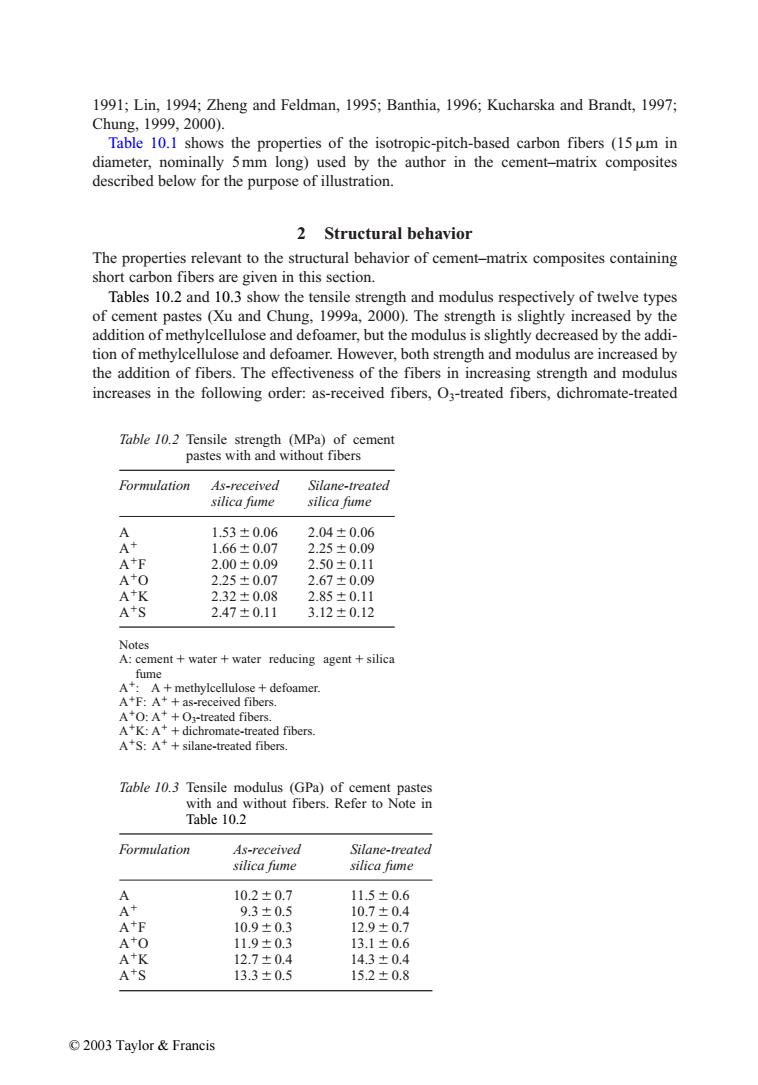正在加载图片...

1991;Lin,1994;Zheng and Feldman,1995;Banthia,1996;Kucharska and Brandt,1997; Chung,1999,2000). Table 10.1 shows the properties of the isotropic-pitch-based carbon fibers(15 um in diameter,nominally 5mm long)used by the author in the cement-matrix composites described below for the purpose of illustration. 2 Structural behavior The properties relevant to the structural behavior of cement-matrix composites containing short carbon fibers are given in this section. Tables 10.2 and 10.3 show the tensile strength and modulus respectively of twelve types of cement pastes (Xu and Chung,1999a,2000).The strength is slightly increased by the addition of methylcellulose and defoamer,but the modulus is slightly decreased by the addi- tion of methylcellulose and defoamer.However,both strength and modulus are increased by the addition of fibers.The effectiveness of the fibers in increasing strength and modulus increases in the following order:as-received fibers,O3-treated fibers,dichromate-treated Table 10.2 Tensile strength (MPa)of cement pastes with and without fibers Formulation As-received Silane-treated silica fume silica fume A 1.53±0.06 2.04±0.06 A+ 1.66±0.07 2.25±0.09 A 2.00±0.09 2.50±0.11 A+0 2.25±0.07 2.67±0.09 AK 2.32±0.08 2.85±0.11 A+S 2.47±0.11 3.12±0.12 Notes A:cement water water reducing agent silica fume A+:A+methylcellulose +defoamer. A+F:A++as-received fibers. A*O:A++O3-treated fibers. A*K:A+dichromate-treated fibers. A*S:A++silane-treated fibers. Table 10.3 Tensile modulus (GPa)of cement pastes with and without fibers.Refer to Note in Table 10.2 Formulation As-received Silane-treated silica fume silica fume A 10.2±0.7 11.5±0.6 A+ 9.3±0.5 10.7±0.4 AF 10.9±0.3 12.9±0.7 AO 11.9±0.3 13.1±0.6 A+K 12.7±0.4 14.3±0.4 A+S 13.3±0.5 15.2±0.8 ©2003 Taylor&Francis1991; Lin, 1994; Zheng and Feldman, 1995; Banthia, 1996; Kucharska and Brandt, 1997; Chung, 1999, 2000). Table 10.1 shows the properties of the isotropic-pitch-based carbon fibers (15m in diameter, nominally 5mm long) used by the author in the cement–matrix composites described below for the purpose of illustration. 2 Structural behavior The properties relevant to the structural behavior of cement–matrix composites containing short carbon fibers are given in this section. Tables 10.2 and 10.3 show the tensile strength and modulus respectively of twelve types of cement pastes (Xu and Chung, 1999a, 2000). The strength is slightly increased by the addition of methylcellulose and defoamer, but the modulus is slightly decreased by the addition of methylcellulose and defoamer. However, both strength and modulus are increased by the addition of fibers. The effectiveness of the fibers in increasing strength and modulus increases in the following order: as-received fibers, O3-treated fibers, dichromate-treated Table 10.2 Tensile strength (MPa) of cement pastes with and without fibers Formulation As-received Silane-treated silica fume silica fume A 1.53 0.06 2.04 0.06 A 1.66 0.07 2.25 0.09 AF 2.00 0.09 2.50 0.11 AO 2.25 0.07 2.67 0.09 AK 2.32 0.08 2.85 0.11 AS 2.47 0.11 3.12 0.12 Notes A: cement water water reducing agent silica fume A: A methylcellulose defoamer. AF: A as-received fibers. AO: A O3-treated fibers. AK: A dichromate-treated fibers. AS: A silane-treated fibers. Table 10.3 Tensile modulus (GPa) of cement pastes with and without fibers. Refer to Note in Table 10.2 Formulation As-received Silane-treated silica fume silica fume A 10.2 0.7 11.5 0.6 A 9.3 0.5 10.7 0.4 AF 10.9 0.3 12.9 0.7 AO 11.9 0.3 13.1 0.6 AK 12.7 0.4 14.3 0.4 AS 13.3 0.5 15.2 0.8 © 2003 Taylor & Francis����������������������������